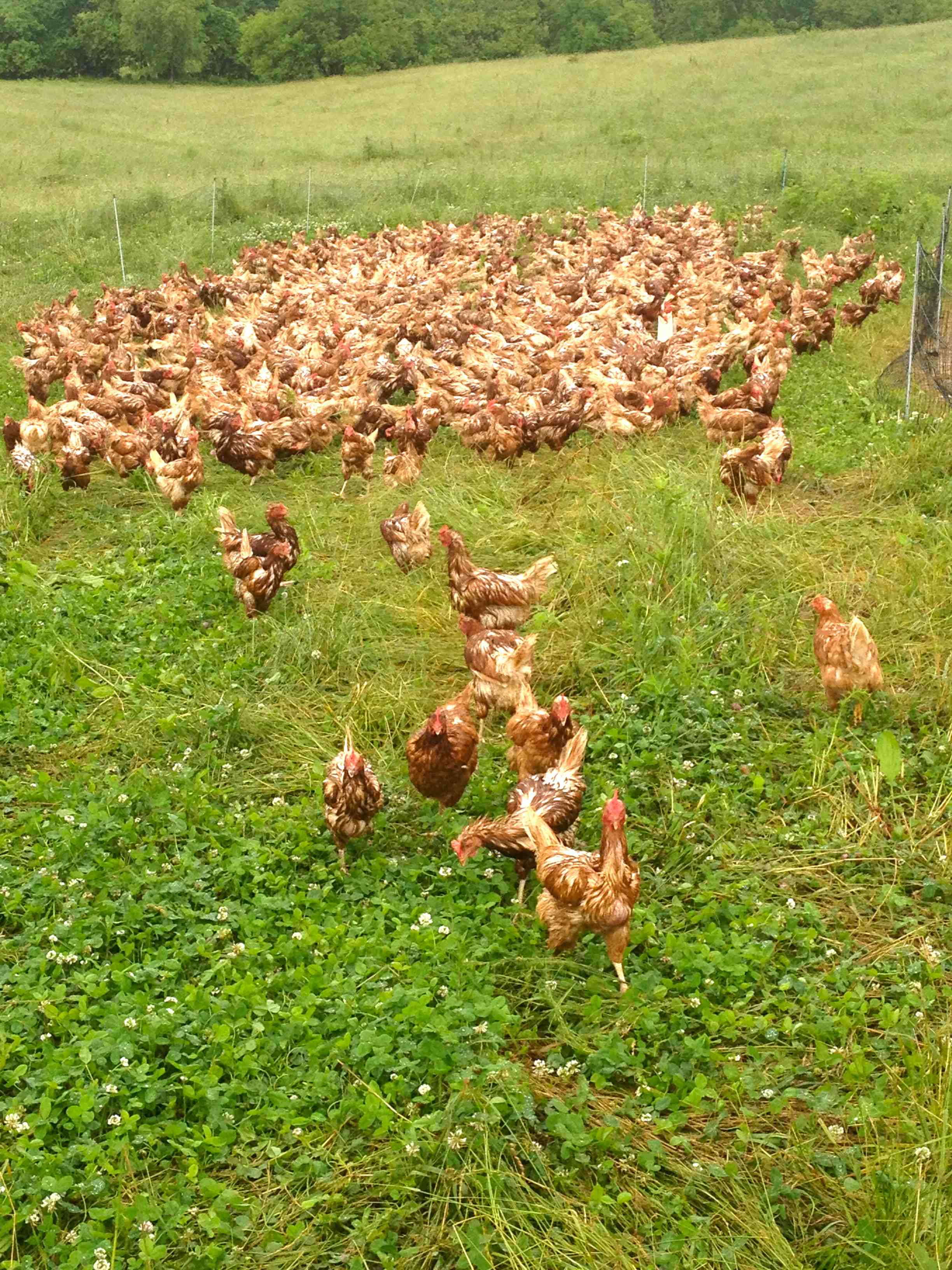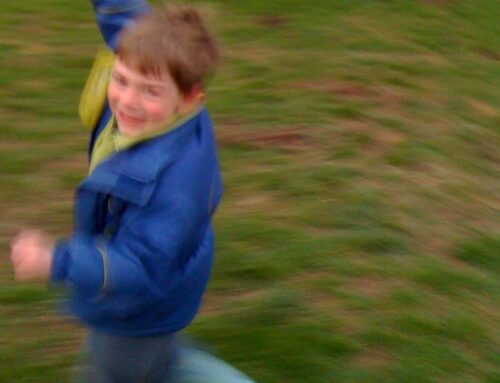
A panoramic view of our free-range poultry field, from the top of our laying coop. If you look carefully, you can see our layers roaming more than a quarter of a mile, beside the white hutch in the upper right of the photo.
The art of grass farming is quickly gaining global respect. A ‘grass roots’ movement in the purest form, intensive pasture management tantalizes us with its broader possibilities. From carbon sequestration and increased rainfall retention, to accelerated nutrient capture, grass farming is increasingly upheld as a shining light of sustainable agriculture. At long last, we’re realizing that many of the answers our ecological problems might lie beneath our very feet.
Yet when it comes to grazing, we often only think of cattle (and to a lesser degree, bison and sheep). But after two decades of raising chickens on pasture, I can personally attest to the positive effect that a well-managed flock of chickens can have on soil fertility. Small flocks can make a big impact, especially on micro to medium sized acreages where chickens might be a better fit than cows. So without further ado, here’s a step-by-by step primer on how to get maximum return for your free-range efforts, while simultaneously healing your soil and generating a profit for your bottom line.
What is Mob Grazing?

This our ‘mob’ of chickens, 1,100 in all, just after a big rainstorm. They are rotated frequently onto fresh pasture.
First, let’s define mob grazing. Simply put, mob grazing is a lot like it sounds: a large ‘mob’ of animals that are eating all at once, in a relatively small area. Have you ever been packed like a sardine at a sold-out concert or summer festival? You know the feeling, an ocean people everywhere you turn. That’s the basic principle of mob grazing: lots of animals on a small amount of acreage.
But unlike a rock concert, on a well-managed farm the mob is always moving. Otherwise known as ‘rotation,’ the tightly bunched group of animals only stays in one place for a short time before moving on. It’s the farmer’s job to ensure that there’s always plenty of pasture for the mob so they never go hungry. Picture it as the “ultimate, never-ending buffet line.”
So why is this such a great idea? Because it’s precisely how animals behave in nature. Cattle move in herds, and sheep move in flocks. There’s safety in numbers, and animals know this. No one wakes up in the morning wanting to be eaten by a wolf.
It’s through mimicking these natural behaviors that farmers can greatly increase soil fertility. As the cattle move, they trample the grass, effectively ‘mulching’ the field where they’re grazing. While getting their fill to eat, they also crush and ‘waste’ a lot of grass as they go. But just like mulching a flower bed or garden, this ‘waste’ isn’t actually wasteful at all. It creates a moisture barrier for the topsoil, trapping crucial rainfall. At the same time, it helps to reduce surface temperatures, and fosters a favorable habitat for beneficial earthworms and insects. Instead of driving to the Home Depot for bags of mulch, the farmer puts the animals in position to do this themselves.
Better yet, because they are tightly bunched, the animals spread their manure and urine evenly across the field. Whereas five or six cows might only poop on a handful of spots in a one acre field, fifty cows in the same area can do ten times as much fertilizing. Of course, fifty cows can’t remain on an acre for very long, so it’s up to the farmer to keep the group moving, often once or twice a day. Graze, trample, poop and move. If everything goes right, the pasture will get a month or more to ‘rest,’ allowing the grass to recover, process the natural fertilizer, capture carbon in its roots and rejuvenate itself. It’s one big circle of life, and the practice holds great promise for the future of sustainable agriculture.
Mob Grazing with Chickens
Now that we understand the basic concepts, how do we do this with chickens? First of all, we need to think smaller scale. An average chicken is only three or four pounds, as opposed to a fifteen-hundred pound cow. Needless to say, a little chicken can’t trample grass as well as a full grown steer! Or… can they? If properly managed, could chickens graze as well as a mob of cattle? In my opinion, the answer is a resounding ‘yes’. Here’s how.
 First things first. Thank you, Thomas Edison: Without electricity, this might not be possible. It all starts with electrified poultry netting. Why electrified netting? Because foxes, coyotes and neighbor’s dogs LOVE to eat chickens. By putting a ‘hot’ current on the net, not only do we keep our chickens from being slaughtered by predators, but we can effectively control where our birds graze… and how many of them are grazing in the same location.
First things first. Thank you, Thomas Edison: Without electricity, this might not be possible. It all starts with electrified poultry netting. Why electrified netting? Because foxes, coyotes and neighbor’s dogs LOVE to eat chickens. By putting a ‘hot’ current on the net, not only do we keep our chickens from being slaughtered by predators, but we can effectively control where our birds graze… and how many of them are grazing in the same location.
On our farm, it all starts with the Hub System. This is an idea I modified many years ago from Timothy Shell, and it works fabulously for chickens (and pigs, too). The basic premise is reminiscent of a wagon wheel. The center, or ‘hub,’ is where the coop sits, remaining stationary. The ‘spokes,’ extending out from the hub, form a circular perimeter (the wheel itself). To illustrate exactly what I mean, I’ve included these diagrams to the right.
In essence, we roll or drag a mobile coop onto a pasture, where the chickens take shelter at night, or retreat during inclement weather. They have access to the outdoors 365 days a year, even in the snow. (I’ve written a comprehensive blog about how all this works HERE, along with an accompanying videos HERE and HERE.) From the stationary coop, there are access doors cut all the way around, so the nets can operate like ‘spokes’ on the wagon wheel. These are long, narrow alleys that the chickens access daily, providing them with fresh pasture each morning.
 But how do we get them to trample and mob graze? That’s the real trick, where lots of patience and skill enters into the equation. In chronological order, here’s a slew of insider tips to get your flock of chickens mob grazing every bit as well as a herd of cattle.
But how do we get them to trample and mob graze? That’s the real trick, where lots of patience and skill enters into the equation. In chronological order, here’s a slew of insider tips to get your flock of chickens mob grazing every bit as well as a herd of cattle.
Getting your Chickens to Trample Like Cattle
The first week on pasture actually means that the chicks (and I’m referring to meat chickens here, but the same goes for 17 weeks old laying pullets) aren’t actually ‘chicks’ at all: they are 3-4 weeks old, and recently removed from the safe confines of the brooder. Our hutches are 12 feet by 16, and we stock them with 200 birds apiece. Once we put them inside the hutch (deep bedded 2-3 inches with pine shavings, and manually flipped every morning with a pitch fork), we keep the birds inside an additional 3 days to get them acclimated and ‘homed in’ to their new surroundings. On day five we open a door onto pasture and move their feed troughs JUST outside the door, to encourage them to venture outside. It’s a big scary word out there, much like our first recess in Kindergarten. For the next two or three days, we keep the feed close to the entrance where they can see it, to build comfort.

200 Cornish Cross chickens at week 7. We never trim the pasture ahead of them, which eliminates extra tractor work. For feed, we hand-allocate our broilers 1/3 lb. feed per bird per day, and our layers 1/5 lb. per bird per day.
At this time we keep the net very wide, at least a fifteen foot width. This allows the chickens to spread out, receive a shock from the net, but not panic and become entangled. When the birds are tightly packed together and one gets a shock, they will scatter like a school of fish, and multiple birds will flee straight into the net and become caught. By spreading out the net on the first week we mitigate this risk, and allow each bird the chance to learn about the net without jeopardizing the rest of the flock. During the first week we don’t rotate the net, because the birds are so small they don’t trample much pasture.
When night falls the birds return to the hutch, and I close the door (although never with the layers, so as not to interrupt their natural biorhythms). The first couple of evenings I have to shoo them in till they get the idea. This makes moving the net in the morning a piece of cake.

Inside the hutch. Deep bedded, at turns cozy and cool… and built like a Chicken Fort Knox. If everything goes right, we only lose about 5% of our birds to mortality and predation.
At week five, the trampling really starts. By now the birds are hankering for their door to be opened each morning, knowing that feed is waiting for them outside. But on the morning of week five, we tighten up the net to a three-to-four foot wide alley, and move their feed about halfway down the run. A single, standard net from Kencove or Premier is typically 165 feet, so this basically provides them an 80 foot run. Each day during week five, we keep moving the feed troughs further down the run, until by the end of the week it’s all the way at the end. From week six through week nine (when the birds are butchered), the nets are moved each and every morning. And a good thing, too… it’s a Trample-Poop-Looza out there!
People tell me that Cornish Cross chickens are lazy, or disposed to sitting all day long. Hogwash! If properly trained and motivated, these birds are superior tramplers and excellent grazers. If you’d like to witness Cornish Cross chickens that—at full maturity—sprint across the pasture, then come visit our farm. But keep out of their way, or they might knock you over as they trample the grass.
What are the Results?

A side-by-side view of a ‘littered’ run and a ‘fresh’ run. We always set up two nets at once for our layers, to make the weekly transition seamless: one door closes, and a new door opens. (See earlier diagrams for reference)
It’s a long known fact that grass loves nitrogen. But chicken manure isn’t just loaded with nitrogen; it also contains beneficial levels of phosphorus, potassium, magnesium and calcium. These are all important nutrients for a well-balanced soil. Because the manure is so potent, it’s paramount that the grass is allowed to ‘rest’ after a good trampling for at least 30 days or longer. This allows rain, insects and microbes to break down the manure into fertilizer, and also speeds pasture recovery to greatly reduce nutrient run-off. We’ve worked hard to trample and fertilize all that grass; now, lets take the extra steps to make sure our efforts don’t go wasted.
On our farm, we dedicate one 15 acre field to poultry each year, then ‘rest’ that field for at least one full year without any chickens. During the poultry year, our chickens might graze a particular swath of field 10 times (with 35 day rests in between). But during the off-year, we give the field time to process all these inputs so as not to overburden it with fertilizer, or allow parasites and pathogens to accumulate. Just like in nature, the animals are always moving. We try to mimmic that behavior as well. (And by the way, the entire time that the chickens are in the field, we’re also rotating our cattle and sheep through, otherwise known as multi-species grazing).
Final Thoughts

Yes, we even free-range our chickens in the snow. If these birds look motivated now, just imagine how they’ll react when they see spring pasture!
Will mob grazing with chickens save the world? Like anything else in the sustainable agriculture movement, it’s simply a part of the solution, another puzzle piece in the carbon/nutrient cycle. But grazing with chickens is especially important due to its scaleability. Poultry is perfectly suited for smaller acreages, and major impacts on soil fertility can be accomplished with a well-managed flock of 200 birds. (200 birds, incidentally, is the minimum economy of scale I would recommend to those hoping to financially break-even on raising chickens. 400 is a better number yet, and gets you headed towards making an actual profit).
Don’t be fooled by the head-scratchingly romantic testimonials of raising free-range chickens. This is genuinely hard work, with a long-term payoff. But I’m here to tell you: this can be done, and done profitably. Moreover, the benefits are far greater than simply raising chickens. We can scientifically improve soil fertility, capture atmospheric pollutants, and all the while produce the world’s tastiest eggs and chicken.
What’s not to like? Let’s make mob grazing a cock-a-doodle do, not a cock-a-doodle don’t. Follow these tips, and you’ll be raising healthier chickens for a healthier planet in no time at all.
Check out my books!












Leave a Reply